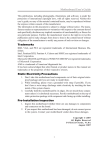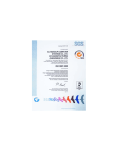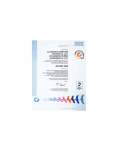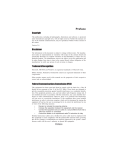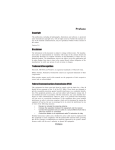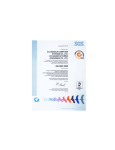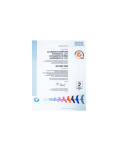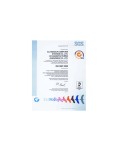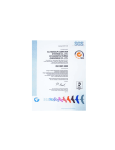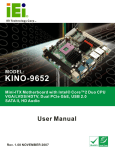Download Global
Transcript
i Preface Copyright This publication, including all photographs, illustrations and software, is protected under international copyright laws, with all rights reserved. Neither this manual, nor any of the material contained herein, may be reproduced without written consent of the author. Version 3.0A Disclaimer The information in this document is subject to change without notice. The manufacturer makes no representations or warranties with respect to the contents hereof and specifically disclaims any implied warranties of merchantability or fitness for any particular purpose. The manufacturer reserves the right to revise this publication and to make changes from time to time in the content hereof without obligation of the manufacturer to notify any person of such revision or changes. Trademark Recognition Microsoft, MS-DOS and Windows are registered trademarks of Microsoft Corp. MMX, Pentium, Pentium-II, Pentium-III, Celeron are registered trademarks of Intel Corporation. Other product names used in this manual are the properties of their respective owners and are acknowledged. Federal Communications Commission (FCC) This equipment has been tested and found to comply with the limits for a Class B digital device, pursuant to Part 15 of the FCC Rules. These limits are designed to provide reasonable protection against harmful interference in a residential installation. This equipment generates, uses, and can radiate radio frequency energy and, if not installed and used in accordance with the instructions, may cause harmful interference to radio communications. However, there is no guarantee that interference will not occur in a particular installation. If this equipment does cause harmful interference to radio or television reception, which can be determined by turning the equipment off and on, the user is encouraged to try to correct the interference by one or more of the following measures: • • • • Reorient or relocate the receiving antenna Increase the separation between the equipment and the receiver Connect the equipment onto an outlet on a circuit different from that to which the receiver is connected Consult the dealer or an experienced radio/TV technician for help Shielded interconnect cables and a shielded AC power cable must be employed with this equipment to ensure compliance with the pertinent RF emission limits governing this device. Changes or modifications not expressly approved by the system’s manufacturer could void the user’s authority to operate the equipment. Preface ii Declaration of Conformity This device complies with part 15 of the FCC rules. Operation is subject to the following conditions: • • This device may not cause harmful interference, and This device must accept any interference received, including interference that may cause undesired operation Canadian Department of Communications This class B digital apparatus meets all requirements of the Canadian Interferencecausing Equipment Regulations. Cet appareil numérique de la classe B respecte toutes les exigences du Réglement sur le matériel brouilieur du Canada. About the Manual The manual consists of the following: Describes features of the motherboard. page 1 Go to H Chapter 1 Introducing the Motherboard Describes installation of motherboard components. Chapter 2 Installing the Motherboard Go to H page 7 Provides information on using the BIOS Setup Utility. Chapter 3 Using BIOS Go to Chapter 4 Using the Motherboard Software H page 29 Describes the motherboard software Go to Preface H page 51 iii TABLE OF CONTENTS Preface i Chapter 1 1 Introducing the Motherboard 1 Introduction...................................................................................1 Feature..............................................................................................2 Motherboard Components..................................................................5 Chapter 2 7 Installing the Motherboard 7 Safety Precautions...........................................................................7 Choosing a Computer Case............................................................7 Installing the Motherboard in a Case............................................7 Checking Jumper Settings...............................................................8 Setting Jumpers.......................................................................8 Checking Jumper Settings.......................................................9 Jumper Settings.......................................................................9 Installing Hardware....................................................................10 Installing the Processor.........................................................10 Installing Memory Modules..................................................12 Expansion Slots....................................................................14 Connecting Optional Devices................................................16 Installing a Hard Disk Drive/CD-ROM/SATA Hard Drive...21 Installing a Floppy Diskette Drive.........................................22 Connecting I/O Devices................................................................23 Connecting Case Components.....................................................25 Front Panel Header...............................................................27 Chapter 3 29 Using BIOS 29 About the Setup Utility................................................................ 29 The Standard Configuration..................................................29 Entering the Setup Utility........................................................29 Using BIOS......................................................................................30 Standard CMOS Features.....................................................31 Advanced BIOS Features......................................................33 Advanced Chipset Features...................................................36 iv Integrated Peripherals.................................................................38 Power Management Setup...........................................................42 PNP/PCI Configurations.............................................................44 PC Health Status..........................................................................45 Frequency Control.......................................................................46 Load Fail-Safe Defaults Option...................................................47 Load Optimized Defaults Option.................................................47 Set Password................................................................................48 Save & Exit Setup.........................................................................48 Exit Without Saving.......................................................................48 Updating the BIOS............................................................49 Chapter 4 51 Using the Motherboard Software 51 About the Software CD-ROM............................................................51 Auto-installing under Windows 2000/XP...................................51 Running Setup........................................................................52 Manual Installation........................................................................54 Utility Software Reference............................................................54 1 Chapter 1 Introducing the Motherboard Introduction Thank you for choosing the 945GCT-M3 motherboard. This motherboard is a high performance, enhanced function motherboard designed to support the LGA775 socket Intel® CoreTM 2 Duo/Pentium ® D/Pentium® 4/Celeron ® D processors for high-end business or personal desktop markets. The motherboard incorporates the 945GC Northbridge (NB) and ICH7 Southbridge (SB) chipsets. The Northbridge supports a Front Side Bus (FSB) frequency of 1066/ 800/533 MHz using a scalable FSB Vcc_CPU. The memory controller supports DDR2 memory DIMM frequencies of 667/533/400. It supports two DDR2 sockets with up to maximum memory of 2 GB. DDR2 memory bandwidth of 4.3 Gb/s in single-channel is supported, or 8.5 Gb/s in dual-channel interleaved mode assuming DDR2 667 MHz. High resolution graphics via one PCI Express slot, intended for Graphics Interface, is fully compliant to the PCI Express Base Specification revision 1.0a. The ICH7 Southbridge supports two PCI slots which are PCI v2.3 compliant. In addition, one PCI Express x1 slot is supported, fully compliant to the PCI Express Base Specification, Revision 1.0a. It implements an EHCI compliant interface that provides 480 Mb/s bandwidth for eight USB 2.0 ports. One onboard IDE connector supports 2 IDE devices in Ultra ATA 100/66/33 mode. The Southbridge integrates a Serial ATA host controller that is SATA II compliant, supporting four SATA ports with maximum transfer rate up to 3.0 Gb/s each. The motherboard is equipped with advanced full set of I/O ports in the rear panel, including PS/2 mouse and keyboard connectors, COM1, LPT, one VGA port, four USB ports, one LAN port, one optional 1394a port and audio jacks for microphone, line-in and 6/8-channel (optional) line out. Introducing the Motherboard 2 Feature Processor The motherboard uses an LGA775 type of Intel ® CoreTM 2 Duo/Pentium® D/ Pentium® 4/Celeron® D that carries the following features: • • • Accommodates Intel® CoreTM 2 Duo/Pentium® D/Pentium® 4/Celeron® D processors Supports a system bus (FSB) of 1066/800/533 MHz Supports “Hyper-Threading” technology CPU “Hyper-Threading” technology enables the operating system into thinking it’s hooked up to two processors, allowing two threads to be run in parallel, both on separate “logical” processors within the same physical processor. Chipset The 945GC Northbridge (NB) and ICH7 Southbridge (SB) chipsets are based on an innovative and scalable architecture with proven reliability and performance. 945GC (NB) • • • • • ICH7 (SB) • • • • • • Supports 32-bit host bus addressing, allowing the CPU to access the entire 2 GB of the memory address space 2 GB/s point-to-point Direct Media Interface (DMI) to ICH7 (1 Gb/s) each direction Supports one PCI Express x16 for Graphics Interface, fully compliant to the PCI Express Base Specification revision 1.0a. Supports 256-Mb, 512-Mb and 1-Gb DDR2 technologies for x8 and x16 devices Supports high quality 3D setup, Render Engine and high-quality texture engine Enhanced DMA Controller, interrupt controller, and timer functions Compliant with PCI Express Base Specification, Revision 1.0a Compliant with PCI 2.3 specification Integrated SATA 3.0 Gb/s Host Controller Integrated USB 2.0 Host Controller supporting up to eight USB 2.0 ports Integrated IDE controller supports Ultra ATA 100/66/33 Memory • • • Supports DDR2 667/533/400 DDR SDRAM with Dual-channel architecture Accommodates two unbuffered DIMMs Up to 1 GB per DIMM with maximum memory size up to 2 GB Introducing the Motherboard 3 1394a FireWire (Optional) • • • Compliant with single chip host controller for IEEE Std 1394-1995 and IEEE 1394a-2000 Integrated 400 Mbit 2-Port PHY for the PCI BUS 3.3V Power Supply with 5V Tolerant Inputs Onboard LAN (Optional) The onboard LAN controller provides the following features: • • • Integrated 10/100/1000 transceiver Supports PCI v2.3, 32-bit, 33/66 MHz Supports fully with IEEE802.3, IEEE802.3u and IEEE802.3ab • • • Supports 10/100 Mb/s N-Way Auto negotiation operation Half/Full duplex capacity Supports wake-On-LAN (WOL) function and remote wake-up Audio (Optional) • • • • • • • • • • • • • • • • • 8-channel of DAC support 24/20/16-bit PCM format for 7.1 audio solution Support 192K/96K/48K/44.1KHz DAC sample rate Power support: Digital: 3.3V; Analog: 3.3V~5.25V Meets Microsoft WHQL/WLP 2.0 audio requirements Direct Sound 3DTM compatible Dolby Digital Encorder output for consumer electronic application Compliant with Intel High Definition Audio, supporting 8-channel DACs with 95dB S/N ratio Capabilities: 192/96/48/44.1 KHz with 24/20/16 bits Power support: Digital: 3.3V; Analog: 3.3V/5.0V All analog jacks are stereo input and output re-tasking for analog plug & play Meets Microsoft WHQL/WLP 2.0 audio requirements Direct Sound 3DTM compatible Dolby Digital Encoder output for consumer electronic application Compliant with the AC’97 v2.3 CODEC Supports 6-channel audio CODEC designed for PC multimedia systems Provides three analog line-level stereo inputs with 5-bit volume control: Line-in ,CD,AUX Meets Microsoft WHQL/WLP 2.0 audio requirements Introducing the Motherboard 4 Expansion Options The motherboard comes with the following expansion options: • • • • • • One PCI Express x16 slot for Graphic Interface One PCI Express x1 slot Two 32-bit PCI v2.3 compliant slots One 40-pin IDE low profile header that support two IDE devices One floppy disk drive interface Four 7-pin SATA connectors The motherboard supports UDMA bus mastering with transfer rates of 100/66/33 Mb/s. Integrated I/O The motherboard has a full set of I/O ports and connectors: • • • • • • • • Two PS/2 ports for mouse and keyboard One serial port One parallel port One VGA port Four USB ports One 1394a port (optional) One LAN port Audio jacks for microphone, line-in and 6/8-channel (optional) lineout BIOS Firmware This motherboard uses Award BIOS that enables users to configure many system features including the following: • • • • Power management Wake-up alarms CPU parameters CPU and memroy timing The firmware can also be used to set parameters for different processor clock speeds. 1. Some hardware specifications and software items are subject to change without prior notice. 2. Due to chipset limitation, we recommend that motherboard be operated in the ambiance between 0 and 50 ° C. Introducing the Motherboard 5 Motherboard Components Table of Motherboard Components LABEL 1. CPU Socket ® 2. CPU_FAN 3. DIMM1~2 4. IRDA 5. FDD 6. ATX1 7. IDE1 8. CHS_FAN 9. CLR_CMOS 10. EL** 11. SATA1~4 12. PANEL1 13. JLPC** 14. USB1~2 15. 1394A2* 16. BIOS_WP 17. COM2* 18. WOL1* 19. SPDIFO or S/PDIF** 20. F_AUDIO 21. AUX_IN* 22. PCI1~2 23. PCIE1 24. PCIEX16 25. SYS_FAN 26. ATX12V * COMPONENTS ® LGA775 socket for Intel CoreTM 2 Duo/Pentium® D ® /Pentium 4/Celeron D CPUs CPU cooling fan connector 240-pin DDR2 SDRAM slots Infrared header Floppy disk drive connector Standard 24-pin ATX power connector Primary IDE connector System cooling fan connector Clear CMOS jumper LED header Serial ATA connectors Front panel switch/LED header Low pin count header Front Panel USB headers IEEE 1394a header BIOS flash protect jumper Onboard Serial port header Wake On LAN connector SPDIF out header Front panel audio header Auxiliary In connector 32-bit add-on card slots PCI Express x1 slot PCI Express slot for graphics interface System cooling fan connector Auxiliary 4-pin power connector Stands for optional components ** Please be noted S/PDIF header is for special customers. This concludes Chapter 1. The next chapter explains how to install the motherboard. Introducing the Motherboard 6 Memo Introducing the Motherboard 7 Chapter 2 Installing the Motherboard Safety Precautions • • • • • Follow these safety precautions when installing the motherboard Wear a grounding strap attached to a grounded device to avoid damage from static electricity Discharge static electricity by touching the metal case of a safely grounded object before working on the motherboard Leave components in the static-proof bags they came in Hold all circuit boards by the edges. Do not bend circuit boards Choosing a Computer Case There are many types of computer cases on the market. The motherboard complies with the specifications for the Micro ATX system case. First, some features on the motherboard are implemented by cabling connectors on the motherboard to indicators and switches on the system case. Make sure that your case supports all the features required. Secondly, this motherboard supports one floppy diskette drive and two enhanced IDE drives. Make sure that your case has sufficient power and space for all drives that you intend to install. Most cases have a choice of I/O templates in the rear panel. Make sure that the I/O template in the case matches the I/O ports installed on the rear edge of the motherboard. This motherboard carries a Micro ATX form factor of 244 x 244 mm. Choose a case that accommodates this form factor. Installing the Motherboard in a Case Refer to the following illustration and instructions for installing the motherboard in a case. Most system cases have mounting brackets installed in the case, which correspond the holes in the motherboard. Place the motherboard over the mounting brackets and secure the motherboard onto the mounting brackets with screws. Ensure that your case has an I/O template that supports the I/O ports and expansion slots on your motherboard. Installing the Motherboard 8 Do not over-tighten the screws as this can stress the motherboard. Checking Jumper Settings This section explains how to set jumpers for correct configuration of the motherboard. Setting Jumpers Use the motherboard jumpers to set system configuration options. Jumpers with more than one pin are numbered. When setting the jumpers, ensure that the jumper caps are placed on the correct pins. The illustrations show a 2-pin jumper. When the jumper cap is placed on both pins, the jumper is SHORT. If you remove the jumper cap, or place the jumper cap on just one pin, the jumper is OPEN. SHORT This illustration shows a 3-pin jumper. Pins 1 and 2 are SHORT. Installing the Motherboard OPEN 9 Checking Jumper Settings The following illustration shows the location of the motherboard jumpers. Pin 1 is labeled. Jumper Settings Jumper Type Description Setting (default) 1-2: NORMAL CLR_CMOS 3-pin CLR_CMOS BIOS_WP 2-pin 2-3: CLEAR CMOS Before clearing the CMOS, make sure to turn off the system. 1 CLR_CMOS FLASH OPEN: WRITE UNPROTECT 1 PROTECT SHORT: WRITE PROTECT BIOS_WP To avoid the system unstability after clearing CMOS, we recommend users to enter the main BIOS setting page to “Load Optimal Defaults” and then “Save Changes and Exit”. Installing the Motherboard 10 Installing Hardware Installing the Processor Caution: When installing a CPU heatsink and cooling fan make sure that you DO NOT scratch the motherboard or any of the surfacemount resistors with the clip of the cooling fan. If the clip of the cooling fan scrapes across the motherboard, you may cause serious damage to the motherboard or its components. On most motherboards, there are small surface-mount resistors near the processor socket, which may be damaged if the cooling fan is carelessly installed. Avoid using cooling fans with sharp edges on the fan casing and the clips. Also, install the cooling fan in a well-lit work area so that you can clearly see the motherboard and processor socket. Before installing the Processor This motherboard automatically determines the CPU clock frequency and system bus frequency for the processor. You may be able to change the settings in the system Setup Utility. We strongly recommend that you do not over-clock processors or other components to run faster than their rated speed. Warning: 1. Over-clocking components can adversely affect the reliability of the system and introduce errors into your system. Over-clocking can permanently damage the motherboard by generating excess heat in components that are run beyond the rated limits. 2. Always remove the AC power by unplugging the power cord from the power outlet before installing or removing the motherboard or other hardware components. This motherboard has a LGA775 socket. When choosing a processor, consider the performance requirements of the system. Performance is based on the processor design, the clock speed and system bus frequency of the processor, and the quantity of internal cache memory and external cache memory. Installing the Motherboard 11 CPU Installation Procedure The following illustration shows CPU installation components. A. Read and follow the instructions shown on the sticker on the CPU cap. B. Unload the cap · Use thumb & forefinger to hold the lifting tab of the cap. · Lift the cap up and remove the cap completely from the socket. C. Open the load plate · Use thumb & forefinger to hold the hook of the lever, pushing down and pulling aside unlock it. · Lift up the lever. · Use thumb to open the load plate. Be careful not to touch the contacts. D. Install the CPU on the socket · Orientate CPU package to the socket. Make sure you match triangle marker to pin 1 location. E. Close the load plate · Slightly push down the load plate onto the tongue side, and hook the lever. · CPU is locked completely. F. Apply thermal grease on top of the CPU. G. Fasten the cooling fan supporting base onto the CPU socket on the motherboard. H. Make sure the CPU fan is plugged to the CPU fan connector. Please refer to the CPU cooling fan user’s manual for more detail installation procedure. 1. To achieve better airflow rates and heat dissipation, we suggest that you use a high quality fan with 3800 rpm at least. CPU fan and heatsink installation procedures may vary with the type of CPU fan/heatsink sup plied. The form and size of fan/heatsink may also vary. 2. DO NOT remove the CPU cap from the socket before installing a CPU. 3. Return Material Authorization (RMA) requests will be accepted only if the motherboard comes with thecap on the LGA775 socket. Installing the Motherboard 12 Installing Memory Modules This motherboard accommodates two memory modules. It can support two 240-pin DDR2 667/533/400. The total memory capacity is 2 GB. DDR2 SDRAM memory module table Memory module Memory Bus DDR2 400 200 MHz DDR2 533 DDR2 667 266 MHz 333 MHz You must install at least one module in any of the two slots. Each module can be installed with 256 MB to 1 GB of memory; total memory capacity is 2 GB. Do not remove any memory module from its antistatic packaging until you are ready to install it on the motherboard. Handle the modules only by their edges. Do not touch the components or metal parts. Always wear a grounding strap when you handle the modules. Installation Procedure Refer to the following to install the memory modules. 1 2 3 4 5 6 This motherboard supports unbuffered DDR2 SDRAM . Push the latches on each side of the DIMM slot down. Align the memory module with the slot. The DIMM slots are keyed with notches and the DIMMs are keyed with cutouts so that they can only be installed correctly. Check that the cutouts on the DIMM module edge connector match the notches in the DIMM slot. Install the DIMM module into the slot and press it firmly down until it seats correctly. The slot latches are levered upwards and latch on to the edges of the DIMM. Install any remaining DIMM modules. Installing the Motherboard 13 Table A: DDR2(memory module) QVL (Qualified Vendor List) The following DDR2 667/533/400 memory modules have been tested and qualified for use with this motherboard. Type Size DDR2 400 256 MB 512 MB Vendor Module Name Samsung K4T51163QB-ZCCC Samsung Twinmos Corsair Corsair Eipida 256 MB Elpida Hynix Kingmax Kingston Kingston Nanya Ramaxel Ramaxel Twinmos DDR2 533 Aeneon Aeneon Corsair 512 MB Eipida Hynix Kingston Kingston Kingston Ramaxel Ramaxel Ramaxel Samsung Samsung Twinmos Apacer 1 GB Geil Hynix Infineon Kingmax PQI UMAX 256MB Infineon Ramxel A-DATA A-DATA Corsair Corsair Corsair GEIL 512MB GEIL DDR2 667 Infinity Ramxel Samsung Samsung Sync MAX Transcend Transcend Transcend Twinmos Apacer 1GB Apacer Infineon PQI K4T51083QB-GCCC Samsung K4T51083QB-GCCC 4PB11D9CHM Aeneon AET94F-370 E2508AA-DF-E E2508AA-T7F-E HY5PS121621 Hynix HY5PS121621 Elpida E5116F-5C-E Infineon KVR533D2N4/256HYB18T512260AF-3.7 Nanya NT5TU32M16AG-37B Elpida D5116AF-5C-E 5PB42D9DCD Elpida 8D22IB-ED Aeneon AET93F370 SS Aeneon AET94F370 DS Samsung K4T51083QB-ZCD5 Eipida 04180WB01 HY5PS12821 Hynix HYB18T512800AF37 Hynix HY5PS12821 Nanya NT5TU64M8AE-37B Elpida E5108AG-5C-E 5PB32D9DCN 6AD11D9GCT K4T51083QC K4T51083QF-ZCD5 Elpida E5108AB-5C-E Eipida E5108AB-5C-E A016E2864T2AG8AKT5H120001 Hynix HY5P512821 F-C4 HY818T512800AF3733344539 Kingmax KKEA88E4AAKG-37 PQB2648D38R0651 U2S12D30TP-5C HYS64T325001HU-3-A HYB18T256 5NB31 D9DCG AD29608A88-3EG Eipida M20EL5G3H3160B100Z E5108AE-6E-E Corsair K4T5108QC VALUESELECT 32M8CEC 64M8CFE PS1000545 GL2L64M088BA18W GL2L64M088BA30AW 0547W64M8 PC5300 5LB31 D9DCL K4T51083QC PC35300U-25331-Z K4T56083QF-ZCE6 04400WB01 R050008A JetRam J12Q3AB-6 SEL520ZCE6 K4T51083QC TAIWAN-G6E TMM6208G8M30B AM4B5708GQJS7E0631F Elpida AM4B5708GQJ7E0631 HYB18T512800BF3S PQB2648D38R0648 Installing the Motherboard 14 Expansion Slots Installing Add-on Cards The slots on this motherboard are designed to hold expansion cards and connect them to the system bus. Expansion slots are a means of adding or enhancing the motherboard’s features and capabilities. With these efficient facilities, you can increase the motherboard’s capabilities by adding hardware that performs tasks that are not part of the basic system. PCIEX16 The PCI Express x16 slot is fully compliant to the PCI Express Base Specification revision 1.0a. slot PCIE1 slot The PCI Express x1 slot is fully compliant to the PCI Express Base Specification revision 1.0a as well. PCI 1~2 This motherboard is equipped with two standard PCI slots. PCI stands for Peripheral Component Interconnect and is a bus standard for expansion slots cards, which for the most part, is a supplement of the older ISA bus standard. The PCI slots on this board are PCI v2.3 compliant. Before installing an add-on card, check the documentation for the card carefully. If the card is not Plug and Play, you may have to manually configure the card before installation. Installing the Motherboard 15 Follow these instructions to install an add-on card: 1 2 3 Remove a blanking plate from the system case corresponding to the slot you are going to use. Install the edge connector of the add-on card into the expansion slot. Ensure that the edge connector is correctly seated in the slot. Secure the metal bracket of the card to the system case with a screw. For some add-on cards, for example graphics adapters and network adapters, you have to install drivers and software before you can begin using the add-on card. Installing the Motherboard 16 Connecting Optional Devices Refer to the following for information on connecting the motherboard’s optional devices: SATA1~4: Serial ATA connectors These connectors are use to support the new Serial ATA devices for the highest date transfer rates (3.0 Gb/s), simpler disk drive cabling and easier PC assembly. It eliminates limitations of the current Parallel ATA interface. But maintains register compatibility and software compatibility with Parallel ATA. Pin Signal Name 1 3 Ground 5 7 Pin Signal Name TX+ TX- 2 4 RXGround 6 - RX+ - Ground Installing the Motherboard 17 F_AUDIO: Front Panel Audio header for Azalia This header allows the user to install auxiliary front-oriented microphone and 6/8channel (optional) line-out ports for easier access. Pin 1 2 3 4 5 6 7 AUD_MIC Function Pin Signal Name Front Panel Microphone input signal AUD_GND Ground used by Analog Audio Circuits MIC_BIAS Microphone Power 8 9 10 Key No Pin AUD_F_L Left Channel Audio signal to Front Panel AUD_RET_L Left Channel Audio signal to Return from Front Panel Pin Pin 1 3 5 7 9 Signal Name AUD_VCC Filtered +5V used by Analog Audio Circuits AUD_F_R Right Channel audio signal to Front Panel AUD_RET_R RightChannelAudiosignaltoReturnfromFrontPanel REVD Reserved Signal Name Signal Name PORT 1L PORT 1R PORT 2R SENSE_SEND PORT 2L Pin Signal Name Function GND 2 4 6 8 10 PRESENCE# Sense1_return KEY Sense2_return 1394A2: IEEE 1394A header (optional) Connect this header to any device with IEEE 1394a interface. Pin Pin 1 3 5 7 9 Signal Name Signal Name TPA1P GND TPB1P CPWR2 Key Pin 2 4 6 8 10 Signal Name Function TPA1M GND TPB1M CPWR2 GND AUX_IN: Auxiliary In header (optional) Pin 1 2 3 4 Signal Name Function AUX_L AUX In left channel Ground Ground AUX In right channel GND GND AUX_R Installing the Motherboard 18 WOL1: Wake On LAN connector (optional) If you have installed a LAN card, use the cable provided with the card to plug into the WOL connector onboard. This enables the Wake On LAN (WOL) feature. When your system is in a power-saving mode, any LAN signal automatically resumes the system. You must enable this item using the Power Management page of the Setup Utility in the BIOS. See Chapter 3 for more information. Pin Signal Name Function 1 2 5VSB +5V stand by power GND Ground 3 Ring# Wake up signal (low active) IRDA: Infrared header The motherboard supports an Infrared (IRDA) data port. Infrared ports allow the wireless exchange of information between your computer and similarly equipped devices such as printers, laptops, Personal Digital Assistants (PDAs), and other computers. Pin Signal Name 1 2 3 4 VCC Key IRRX GND 5 IRTX EL: LED headers (optional) This is an optional header that is used to switch on and off SATA signal light. Pin Pin Pin Signal Name Name Signal SignalName Name 1 GPIO26 2 3 4 GND 5 6 EL_GRN_LED GND EL_YLW_LED KEY Installing the Motherboard 19 USB1~2: Front Panel USB headers The motherboard has four USB ports installed on the rear edge I/O port array. Additionally, some computer cases have USB ports at the front of the case. If you have this kind of case, use auxiliary USB connector to connect the front-mounted ports to the motherboard. Pin Signal Name Function 1 USBPWR 2 3 4 5 6 USBPWR Front Panel USB Power USB_FP_P0- USB Port 0 Negative Signal USB_FP_P1- USB Port 1 Negative Signal 7 8 9 10 Front Panel USB Power USB_FP_P0+ USB Port 0 Positive Signal USB_FP_P1+ USB Port 1 Positive Signal GND GND Ground Ground Key No pin USB_FP_OC0 Overcurrent signal Please make sure that the USB cable has the same pin assignment as indicated above. A different pin assignment may cause damage or system hang-up. COM2: Onboard serial port connector (optional) Connect a serial port extension bracket to this header to add a second serial port to your system. Pin 1 2 3 4 5 6 7 8 9 10 Signal Name DCDB SINB SOUTB Function Data Carrier Detect Serial Input UART B Serial Output DTRB UART B Data Terminal Ready GND Ground DSRB Data Set Ready RTSB CTSB RART B Request to Send Clear to Send RI Key Ring Indicator No pin Installing the Motherboard 20 JLPC(Low pin count header ) (optional) Pin Signal Name 1 CK_P_33M_JLPC Pin 2 Signal Name 3 FWH4 4 KEY 5 PCIRST_L1 6 SMBDATA 7 FWH3 8 FWH2 9 VCC3 10 FWH1 GND 11 FWH0 12 GND 13 PENABLE 14 NC SIRQ 15 3VSBY 16 17 GND 18 GND 19 LPCPD_L 20 SMBCLK SPDIFO: SPDIF out header (optional) This is an optional header that provides an SPDIFO (Sony/Philips Digital Interface) output to digital multimedia device through optical fiber or coaxial connector. Pin Signal Name 1 2 3 4 SPDIFOUT +5V Key GND S/PDIF: SPDIF out header (optional) This is an optional header that provides an S/PDIF (Sony/Philips Digital Interface) output to digital multimedia device through optical fiber or coaxial connector. Pin 1 2 3 4 Signal Name +5V Key SPDFOUT GND Installing the Motherboard 21 Installing a Hard Disk Drive/CD-ROM/SATA Hard Drive This section describes how to install IDE devices such as a hard disk drive and a CDROM drive. About IDE Devices Your motherboard has one IDE channel interface. An IDE ribbon cable supporting two IDE devices is bundled with the motherboard. You must orient the cable connector so that the pin1 (color) edge of the cable corresponds to the pin 1 of the I/O port connector. IDE1: IDE Connector This motherboard supports four high data transfer SATA ports with each runs up to 3.0 Gb/s. To get better system performance, we recommend users connect the CDROM to the IDE channel, and set up the hard dives on the SATA ports. IDE devices enclose jumpers or switches used to set the IDE device as MASTER or SLAVE. Refer to the IDE device user’s manual. Installing two IDE devices on one cable, ensure that one device is set to MASTER and the other device is set to SLAVE. The documentation of your IDE device explains how to do this. About SATA Connectors Your motherboard features four SATA connectors supporting a total of four drives. SATA refers to Serial ATA (Advanced Technology Attachment) is the standard interface for the IDE hard drives which are currently used in most PCs. These connectors are well designed and will only fit in one orientation. Locate the SATA connectors on the motherboard and follow the illustration below to install the SATA hard drives. Installing Serial ATA Hard Drives To install the Serial ATA (SATA) hard drives, use the SATA cable that supports the Serial ATA protocol. This SATA cable comes with an SATA power cable. You can connect either end of the SATA cable to the SATA hard drive or the connector on the motherboard. SATA cable (optional) SATA power cable Installing the Motherboard (optional) 22 Refer to the illustration below for proper installation: 1 2 3 Attach either cable end to the connector on the motherboard. Attach the other cable end to the SATA hard drive. Attach the SATA power cable to the SATA hard drive and connect the other end to the power supply. This motherboard does not support the “Hot-Plug” function. Installing a Floppy Diskette Drive FDD: Floppy Disk Connector Connect the single end of the of the floppy connector to the onboard floppy connector firstly, and then connect the remaining plugs on the other end to the floppy drives correspondingly. You must orient the cable connector so that the pin 1 (color) edge of the cable corresponds to the pin 1 of the I/O port connector. Installing the Motherboard 23 Connecting I/O Devices The backplane of the motherboard has the following I/O ports: PS2 Mouse Use the upper PS/2 port to connect a PS/2 pointing device. PS2 Keyboard Use the lower PS/2 port to connect a PS/2 keyboard. Parallel Port (LPT) Use LPT to connect printers or other parallel communication devices. Serial Port (COM1) Use the COM port to connect serial devices such as mice or fax/modems. VGA Port Connect your monitor to the VGA port. 1394a Port (Optional) Use the 1394a port to connect to any firewire device. LAN Port Connect an RJ-45 jack to the LAN port to connect your computer to the Network. USB Ports Use the USB ports to connect USB devices. Audio Ports Use the audio jacks to connect audio devices. The D port is for stereo line-in signal, while the F port is for microphone in signal. This motherboard supports 8-channel audio devices that correspond to the A, B, C, and E port respectively. In addition, all of the 3 ports, B, C, and E provide users with both right & left channels individually. Users please refer to the following note for specific port function definition. A: Center & Woofer D: Line-in B: Back Surround E: Front Out C: Side Surround F: Mic_in Rear The above port definition can be changed to audio input or audio output by changing the driver utility setting. Installing the Motherboard 24 This motherboard may adopt 6-channel audio ports. Use the three audio ports to connect audio devices. The first jack is for stereo line-in signal. The second jack is for stereo line-out signal. The third jack is for microphone. Installing the Motherboard 25 Connecting Case Components After you have installed the motherboard into a case, you can begin connecting the motherboard components. Refer to the following: 1 2 3 4 5 6 Connect the CPU cooling fan cable to CPU_FAN. Connect the system cooling fan connector to SYS_FAN. Connect the case switches and indicator LEDs to the PANEL1. Connect the standard power supply connector to ATX1. Connect the auxiliary case power supply connector to ATX12V. Connect the case cooling fan connector to CHS_FAN . Connecting 24-pin power cable The ATX 24-pin connector allows you to connect to ATX v2.x power supply. With ATX v2.x power supply, users please note that when installing 24-pin power cable, the latches of power cable and the ATX1 match perfectly. 24-pin power cable Connecting 4-pin power cable The ATX12V power connector is used to provide power to the CPU. When installing 4-pin power cable, the latches of power cable and the ATX12V match perfectly. 4-pin power cable Installing the Motherboard 26 CPU_FAN: FAN Power Connector Pin 1 2 3 4 Signal Name Function System Ground Power +12V Sensor CPU FAN control GND +12V Sense PWM Users please note that the fan connector supports the CPU cooling fan of 1.1A ~ 2.2A (26.4W max) at +12V. SYS_FAN/CHS_FAN: FAN Power Connector (optional) Pin 1 2 3 Signal Name Function System Ground Power +12V Sensor GND +12V Sense ATX1: ATX 24-pin Power Connector Pin Signal Name Pin 1 2 3 4 5 6 7 8 9 10 11 12 +3.3V 13 14 15 16 17 18 19 20 21 22 23 24 +3.3V Ground +5V Ground +5V Ground PWRGD +5VSB +12V +12V +3.3V Signal Name +3.3V -12V Ground PS_ON Ground Ground Ground -5V +5V +5V +5V Ground ATX12V: ATX 12V Power Connector Pin 1 2 3 4 Signal Name Ground Ground +12V +12V Installing the Motherboard 27 Front Panel Header The front panel header (PANEL1) provides a standard set of switch and LED headers commonly found on ATX or Micro ATX cases. Refer to the table below for information: Pin Signal Function Pin Signal Function 1 HD_LED_P Hard disk LED(+) 2 FP PWR/SLP *MSG LED(+) 3 HD_LED_N Hard disk LED(- ) 4 FP PWR/SLP *MSG LED(-) 5 RST_SW_N Reset Switch(-) 6 PWR_SW_P Power Switch(+) 7 RST_SW_P Reset Switch(+) 8 PWR_SW_N Power Switch(-) 9 RSVD Reserved 10 Key No pin * MSG LED (dual color or single color) Hard Drive Activity LED Connecting pins 1 and 3 to a front panel mounted LED provides visual indication that data is being read from or written to the hard drive. For the LED to function properly, an IDE drive should be connected to the onboard IDE interface. The LED will also show activity for devices connected to the SCSI (hard drive activity LED) connector. Power/Sleep/Message waiting LED Connecting pins 2 and 4 to a single or dual-color, front panel mounted LED provides power on/off, sleep, and message waiting indication. Reset Switch Supporting the reset function requires connecting pins 5 and 7 to a momentarycontact switch that is normally open. When the switch is closed, the board resets and runs POST. Power Switch Supporting the power on/off function requires connecting pins 6 and 8 to a momentary-contact switch that is normally open. The switch should maintain contact for at least 50 ms to signal the power supply to switch on or off. The time requirement is due to internal de-bounce circuitry. After receiving a power on/off signal, at least two seconds elapses before the power supply recognizes another on/off signal. This concludes Chapter 2. The next chapter covers the BIOS. Installing the Motherboard 28 Memo Installing the Motherboard 29 Chapter 3 Using BIOS About the Setup Utility The computer uses the latest Award BIOS with support for Windows Plug and Play. The CMOS chip on the motherboard contains the ROM setup instructions for configuring the motherboard BIOS. The BIOS (Basic Input and Output System) Setup Utility displays the system’s configuration status and provides you with options to set system parameters. The parameters are stored in battery-backed-up CMOS RAM that saves this information when the power is turned off. When the system is turned back on, the system is configured with the values you stored in CMOS. The BIOS Setup Utility enables you to configure: • • • • Hard drives, diskette drives and peripherals Video display type and display options Password protection from unauthorized use Power Management features The settings made in the Setup Utility affect how the computer performs. Before using the Setup Utility, ensure that you understand the Setup Utility options. This chapter provides explanations for Setup Utility options. The Standard Configuration A standard configuration has already been set in the Setup Utility. However, we recommend that you read this chapter in case you need to make any changes in the future. This Setup Utility should be used: • • • • • when changing the system configuration when a configuration error is detected and you are prompted to make changes to the Setup Utility when trying to resolve IRQ conflicts when making changes to the Power Management configuration when changing the password or making other changes to the Security Setup Entering the Setup Utility When you power on the system, BIOS enters the Power-On Self Test (POST) routines. POST is a series of built-in diagnostics performed by the BIOS. After the POST routines are completed, the following message appears: Press DEL to enter SETUP Using BIOS 30 Pressing the delete key accesses the BIOS Setup Utility: Phoenix-AwardBIOS CMOS Setup Utility: Standard CMOS Features Advanced BIOS Features Frequency/Voltage Control Load Fail-Safe Defaults Advanced Chipset Features Load Optimized Defaults Integrated Peripherals Set Supervisor Password Power Management Setup Set User Password PnP/PCI Configurations Save & Exit Setup PC Health Status Exit without Saving Esc: Quit F10: Save & Exit Setup : Select Item Time, Date, Hard Disk Type... Using BIOS When you start the Setup Utility, the main menu appears. The main menu of the Setup Utility displays a list of the options that are available. A highlight indicates which option is currently selected. Use the cursor arrow keys to move the highlight to other options. When an option is highlighted, execute the option by pressing <Enter>. Some options lead to pop-up dialog boxes that prompt you to verify that you wish to execute that option. Other options lead to dialog boxes that prompt you for information. Some options (marked with a triangle ) lead to submenus that enable you to change the values for the option. Use the cursor arrow keys to scroll through the items in the submenu. In this manual, default values are enclosed in parenthesis. Submenu items are denoted by a triangle . The default BIOS setting for this motherboard applies for most conditions with optimum performance. It is not suggested to change the default values in the BIOS setup and the manufacture takes no responsibility to any damage caused by changing the BIOS settings. BIOS Navigation Keys The BIOS navigation keys are listed below: KEY ESC FUNCTION Exits the current menu Scrolls through the items on a menu +/-/PU/PD Modifies the selected field’s values F10 Saves the current configuration and exits setup F1 Displays a screen that describes all key functions F5 Loads previously saved values to CMOS F6 Loads a minimum configuration for troubleshooting F7 Loads an optimum set of values for peak performance Using BIOS 31 For the purpose of better product maintenance, the manufacture reserves the right to change the BIOS items presented in this manual. The BIOS setup screens shown in this chapter are for reference only and may differ from the actual BIOS. Please visit the manufacture’s website for updated manual. Standard CMOS Features This option displays basic information about your system. Phoenix-AwardBIOS CMOS Setup Utility Standard CMOS Features Date (mm:dd:yy) Sat, Nov 13 1999 Time (hh:mm:ss) 11 : 27 : 18 IDE Channel 0 Master IDE Channel 0 Slave IDE Channel 1 Master IDE Channel 1 Slave Drive A Floppy 3 Mode Support [1.44M, 3.5 in.] [Disabled] Video Halt On [EGA/VGA] [All Errors] Base Memory Extended Memory Total Memory 640K 65535K 1024K Item Help Menu Level Change the day, month, year and century : Move Enter: Select +/-/PU/PD:Value F10:Save ESC:Exit F1: General Help F5:Previous Values F6:Fail-Safe Defaults F7:Optimized Defaults Date and Time The Date and Time items show the current date and time on the computer. If you are running a Windows OS, these items are automatically updated whenever you make changes to the Windows Date and Time Properties utility. IDE Devices (None) Your computer has two IDE channels (Primary and Secondary) and each channel can be installed with one or two devices (Master and Slave). Use these items to configure each device on the IDE channel. This motherboard features four SATA connectors supporting four SATA drives. SATA refers to Serial ATA (Advanced Technology Attachment), the standard interface for the IDE hard drives which are currently used in most PCs. Phoenix-AwardBIOS CMOS Setup Utility IDE Channel 0 Maser IDE HDD Auto-Detection [Press Enter] IDE Channel 0 Master Access Mode [Auto] [Auto] Menu Level Capacity 0MB To auto-detect the HDD’s size, head... on this channel Cylinder Head Precomp Landing Zone Sector 0 0 0 0 0 Item Help : Move Enter: Select +/-/PU/PD:Value F10:Save ESC:Exit F1: General Help F5:Previous Values F6:Fail-Safe Defaults F7:Optimized Defaults Using BIOS 32 IDE HDD Auto-Detection Press <Enter> while this item is highlighted to prompt the Setup Utility to automatically detect and configure an IDE device on the IDE channel. If you are setting up a new hard disk drive that supports LBA mode, more than one line will appear in the parameter box. Choose the line that lists LBA for an LBA drive. IDE Channel 0/1 Master/Slave IDE/Extended IDE Drives (Auto) Leave this item at Auto to enable the system to automatically detect and configure IDE devices on the channel. If it fails to find a device, change the value to Manual and then manually configure the drive by entering the characteristics of the drive in the items described below. Please noted that if you choose IDE Channel 2/3 Master, the item may change to Extended IDE Drive. Refer to your drive’s documentation or look on the drive casing if you need to obtain this information. If no device is installed, change the value to None. Before attempting to configure a hard disk drive, ensure that you have the configuration information supplied by the manufacturer of your hard drive. Incorrect settings can result in your system not recognizing the installed hard disk. Access Mode (Auto) This item defines ways that can be used to access IDE hard disks such as LBA (Large Block Addressing). Leave this value at Auto and the system will automatically decide the fastest way to access the hard disk drive. If you choose IDE Channel 2/ 3 Master, the item only have Large and Auto. Press <Esc> to return to the Standard CMOS Features page. Drive A (1.44M, 3.5 in.) The item defines the characteristics of any diskette drive attached to the system. You can connect one or two diskette drives. Floppy 3 Mode Support (Disabled) Floppy 3 mode refers to a 3.5-inch diskette with a capacity of 1.2 MB. Floppy 3 mode is sometimes used in Japan. Video (EGA/VGA) This item defines the video mode of the system. This motherboard has a built-in VGA graphics system; you must leave this item at the default value. Halt On (All Errors) This item defines the operation of the system POST (Power On Self Test) routine. You can use this item to select which types of errors in the POST are sufficient to halt the system. Base Memory, Extended Memory, and Total Memory These items are automatically detected by the system at start up time. These are display-only fields. You cannot make changes to these fields. Press <Esc> to return to Award BIOS CMOS Setup Utility page. Using BIOS 33 Advanced BIOS Features This option defines advanced information about your system. Phoenix-AwardBIOS CMOS Setup Utility Advanced BIOS Features CPU Feature Hard Disk Boot Priority CPU L1 & L2 Cache CPU L3 Cache Hyper-Threading Technology Quick Power On Self Test First Boot Device Second Boot Device Third Boot Device Boot Other Device Boot Up Floppy Seek Boot Up NumLock Status Gate A20 Option Typematic Rate Setting x Typematic Rate (Chars/Sec0) x Typematic Delay (Msec) Security Option HDD Security Freeze Lock APIC Mode [Press Enter] [Press Enter] [Enabled] [Enabled] [Enabled] [Enabled] [Floppy] [Hard Disk] [CDROM] [Enabled] [Disabled] [On] [Fast] [Disabled] 6 250 [Setup] [Disabled] [Enabled] Item Help Menu Level 123 123 123 123 123 123 123 123 : Move Enter: Select +/-/PU/PD:Value F10:Save ESC:Exit F1: General Help F5:Previous Values F6:Fail-Safe Defaults F7:Optimized Defaults CPU Feature (Press Enter) Users please note that this function is only available for Prescott CPUs. Scroll to this item and press <Enter> to view the following screen: Phoenix-AwardBIOS CMOS Setup Utility CPU Feature Thermal Management Delay Prior to Thermal Thermal Management TM2 Bus Ratio TM2 Bus VID Limit CPUID MaxVal C1E Support Execute Disable Bit Vanderpool Technology Frequency Unlimit Intel (R) SpeedStep (tm) Tech. [Enabled] [16 Min] [Thermal Monitor 2] [0 X] [0.8375V] [Disabled] [Enabled] [Disabled] [Enabled] [Disabled] [Enabled] Item Help Menu Level Thermal Monitor 1 (On die throtting) Thermal Monitor 2 Ratio & VID transition : Move Enter: Select +/-/PU/PD:Value F10:Save ESC:Exit F1: General Help F5:Previous Values F6:Fail-Safe Defaults F7:Optimized Thermal Management (Enabled/Thermal Monitor 2) ) This item displays CPU’s temperature and enables you to set a safe temperature to Prescott CPU. Delay Prior to Thermal (16 Min) Enables you to set the delay time before the CPU enters auto thermal mode. Using BIOS 34 TM2 Bus Ratio (0X) This item represents the frequency (bus ratio) of the throttled performance state that will be initiated when the on-die sensor goes from not hot to hot). TM2 Bus VID (0.8375V) This item represents the voltage of the throttled performance state that will be initiated when the on-die sensor goes from not hot to hot. Limit CPUID MaxVal (Disabled) This item can support Prescott CPUs for old OS. Users please note that under NT 4.0, it must be set “Enabled”, while under WinXP, it must be set “Disabled”. C1E Support (Enabled) Use this item to decrease the bus ratio that reduces the consumption of CPU electricity and power. Execute Disable Bit (Disabled) This item is a security feature that helps you protect your CPU and operating system against malicious software executing code. This item is available when CPU supports the feature. Vanderpool Technology (Enabled) This item enables or disables the Vanderpool Technology. When disabled, forces the VT function will close. Frequency Unlimit (Disabled) This item enables or disables the over-clocking frequency. Intel (R) SpeedStep (tm) Tech. (Enabled) This item enables or disables the Intel (R) SpeedStep (tm) technology. When enabled, allows enhance Intel SpeedStep Technology transitions. Hard Disk Boot Priority (Press Enter) Scroll to this item and press <Enter> to view the following screen: Phoenix-AwardBIOS CMOS Setup Utility Hard Disk Boot Priority 1. Pri.Master: 2. Pri.Slave: 3. Sec. Master: 4. Sec. Slave: 5. USBHDD0: 6. USBHDD1: 7. USBHDD2: 8. Bootable Add-in Cards Item Help Menu Level Use < > or < > to select a device, then press <+> to move it up, or <-> to move it down the list. Press <ESC> to exit this menu. : Move Enter: Select +/-/PU/PD:Value F10:Save ESC:Exit F1: General Help F5:Previous Values F6:Fail-Safe Defaults F7:Optimized Defaults CPU L1&L2 Cache (Enabled) All processors that can be installed in this mainboard use internal level 1 (L1) and external level 2 (L2) cache memory to improve performance. Leave this item at the default value for better performance. Using BIOS 35 CPU L3 Cache (Enabled) This item is only available when processors support L3. Some high-end processors support L3. If the CPU do support L3, you may set this item to enable or disable. Leave this item at the default value for better performance. Hyper-Threading Technology (Enabled) This item is only available when the chipset supports Hyper-Threading and you are using a Hyper-Threading CPU. Quick Power On Self Test (Enabled) Enable this item to shorten the power on testing (POST) and have your system start up faster. You might like to enable this item after you are confident that your system hardware is operating smoothly First/Second/Third Boot Device (Floppy/Hard Disk/CDROM) Use these three items to select the priority and order of the devices that your system searches for an operating system at start-up time. Boot Other Device (Enabled) When enabled, the system searches all other possible locations for an operating system if it fails to find one in the devices specified under the First, Second, and Third boot devices. Boot Up Floppy Seek (Disabled) If this item is enabled, it checks the size of the floppy disk drives at start-up time. You don’t need to enable this item unless you have a legacy diskette drive with 360K capacity. Boot Up NumLock Status (On) This item defines if the keyboard Num Lock key is active when your system is started. Gate A20 Option (Fast) This item defines how the system handles legacy software that was written for an earlier generation of processors. Leave this item at the default value. Typematic Rate Setting (Disabled) If this item is enabled, you can use the following two items to set the typematic rate and the typematic delay settings for your keyboard. • Typematic Rate (Chars/Sec): Use this item to define how many characters per second are generated by a held-down key. • Typematic Delay (Msec): Use this item to define how many milliseconds must elapse before a held-down key begins generating repeat characters. Security Option (Setup) If you have installed password protection, this item defines if the password is required at system start up, or if it is only required when a user tries to enter the Setup Utility. HDD Security Freeze Lock (Disabled) If this item is enabled, it prevents any external application from locking hard drive except for BIOS. Using BIOS 36 APIC Mode (Enabled) This item allows you to enable or disable the APIC (Advanced Programmable Interrupt Controller) mode. APIC provides symmetric multi-processing (SMP) for systems, allowing support for up to 60 processors. OS Select For DRAM > 64 MB (Non-OS2) This item is only required if you have installed more than 64 MB of memory and you are running the OS/2 operating system. Otherwise, leave this item at the default. Report No FDD For WIN 95 (Yes) Set this item to the default if your are running a system with no floppy drive and using Windows 95; this ensures compatibility with the Window 95 logo certification. Delay For HDD (Secs) (3) (Auto) Users may set a delay from DDR 1 to 15ADDR/CMD seconds in theRate cold boot process. Some hard disk drives need extra time to spin up in order to identify correctly. If the system does not start after the memory test, try to add times in this field. Small Logo (EPA) Show (Disabled) Press <Esc> to return to Advanced BIOS Features screen. Advanced Chipset Features These items define critical timing parameters of the motherboard. You should leave the items on this page at their default values unless you are very familiar with the technical specifications of your system hardware. If you change the values incorrectly, you may introduce fatal errors or recurring instability into your system. Phoenix-AwardBIOS CMOS Setup Utility Advanced Chipset Feature DRAM Timing Selectable CAS Latency Time DRAM RAS# to CAS# Delay DRAM RAS# Precharge Precharge delay (tRAS) System Memory Frequency SLP_S4# Assertion Width System BIOS Cacheable Video BIOS Cacheable [By SPD] [Auto] [Auto] [Auto] [Auto] [Auto] [1 to 2 Sec.] [Disabled] [Disabled] ** VGA Setting ** PEG/Onchip VGA Control PEG Force X1 On-Chip Frame Buffer Size DVMT Mode DVMT/FIXED Memory Size Boot Display [Auto] [Disabled] [8MB] [DVMT] [128MB] [Auto] : Move Enter: Select Item Help Menu Level +/-/PU/PD:Value F10:Save ESC:Exit F1: General Help F5:Previous Values F6:Fail-Safe Defaults F7:Optimized Defaults DRAM Timing Selectable (By SPD) The value in this field depends on performance parameters of the installed memory chips (DRAM). Do not change the value from the factory setting unless you install new memory that has a different performance rating than the original DRAMs. Using BIOS 37 CAS Latency Time (Auto) When synchronous DRAM is installed, the number of clock cycles of CAS latency depends on the DRAM timing. Do not reset this field from the default value specified by the system designer. DRAM RAS# to CAS# Delay (Auto) This field allows you insert a timing delay between the CAS and RAS strobe signals, used when DRAM is written to, read from, or refreshed. Disabled gives faster performance; and Enabled gives more stable performance. DRAM RAS# Precharge (Auto) Select the number of CPU clocks allocated for the Row Address Strobe (RAS#) signal to accumulate its charge before the DRAM is refreshed. If insufficient time is allowed, refresh may be incomplete and data lost. Precharge delay (tRAS) The precharge time is the number of cycles it takes for DRAM to accumulate its charge before refresh. System Memory Frequency (Auto) This item sets the main memory frequency. When you use an external graphics card, you can adjust this to enable the best performance for your system. SLP_S4# Assertion Width (1 to 2 Sec.) This item allows you to set the SLP_S4# Assertion Width manually. System BIOS Cacheable (Disabled) This item allows the system to be cached in memory for faster execution. Enable this item for better performance. Video BIOS Cacheable (Disabled) The item allows the video BIOS to be cached in memory for faster execution. PEG/Onchip VGA Control (Auto) This item allows you to choose the primary display card. PEG Force X1 (Disabled) This item is used to select PCI Express X1 forcedly. On-chip Frame Buffer Size (8 MB) This allows you to set the VGA frame buffer size. DVMT Mode (DVMT) DVMT is Dynamic Video Memory Technology. This item helps you select video mode. DVMT/FIXED Memory Size (128 MB) DVMT is Dynamic Video Memory Technology; this item allows you to select a maximum size of dynamic amount usage of video memory. The system would configure the video memory depends on your application. Boot Display (Auto) This item is for Intel define ADD card only. Using BIOS 38 Integrated Peripherals These options display items that define the operation of peripheral components on the system’s input/output ports. Phoenix-AwardBIOS CMOS Setup Utility Integrated Peripherals OnChip IDE Device Onboard Device SuperIO Device Item Help [Press Enter] [Press Enter] [Press Enter] Menu Level : Move Enter: Select +/-/PU/PD:Value F10:Save ESC:Exit F1: General Help F5:Previous Values F6:Fail-Safe Defaults F7:Optimized Defaults OnChip IDE Device (Press Enter) Scroll to this item and press <Enter> to view the following screen: Phoenix-AwardBIOS CMOS Setup Utility OnChip IDE Device IDE HDD Block Mode ATA 66/100 Cable Msg IDE DMA transfer access On-Chip Primary PCI IDE IDE Primary Master PIO IDE Primary Slave PIO IDE Primary Master UDMA IDE Primary Slave UDMA On-Chip Secondary PCI IDE IDE Secondary Master PIO IDE Secondary Slave PIO IDE Secondary Master UDMA IDE Secondary Slave UDMA [Enabled] [Enabled] [Enabled] [Enabled] [Auto] [Auto] [Auto] [Auto] [Enabled] [Auto] [Auto] [Auto] [Auto] ** On-Chip Serial ATA Setting** SATA Mode On-Chip Serial ATA SATA PORT Speed Settings PATA IDE Mode [IDE] [Auto] [Disabled] [Primary] Item Help Menu Level If your IDE hard drive supports block mode select Enabled for automatic detection of the optimal number of block read/writes per sector the drive can support 123 123 123 123 123 123 123 123 : Move Enter: Select +/-/PU/PD:Value F10:Save ESC:Exit F1: General Help F5:Previous Values F6:Fail-Safe Defaults F7:Optimized Defaults IDE HDD Block Mode (Enabled) Block mode is also called block transfer, multiple commands, or multiple sector read/ write. If your IDE hard drive supports block mode (most new drives do), select Enabled for automatic detection of the optimal number of block read/writes per sector the drive can support. ATA 66/100 Cable Msg (Enabled) This item enables or disables the display of the ATA 66/100 Cable MSG. Using BIOS 39 IDE DMA transfer Access (Enabled) This item allows you to enabled the transfer access of the IDE DMA. On-Chip Primary/Secondary PCI IDE (Enabled) The integrated peripheral controller contains an IDE interface with support for two IDE channels. Select Enabled to activate each channel separately. IDE Primary/Secondary Master/Slave PIO (Auto) Each IDE channel supports a master device and a slave device. These four items let you assign which kind of PIO (Programmed Input/Output) is used by IDE devices. Choose Auto to let the system auto detect which PIO mode is best, or select a PIO mode from 0-4. IDE Primary/Secondary Master/Slave UDMA (Auto) This mainboard supports UltraDMA technology, which provides faster access to IDE devices. If you install a device that supports UltraDMA, change the item on this list to Auto. You may have to install the UltraDMA driver supplied with this mainboard in order to use an UltraDMA device SATA Mode (IDE) Use this item to select the mode of the Serial ATA. On-chip Serial ATA (Auto) Enables and disables the built-in on-chip serial ATA. SATA PORT Speed Settings (Disabled) This item is used to select SATA I or SATA II device support forcedly. PATA IDE Mode (Primary) This item is used to set the PATA IDE mode. When set to Primary, P1 and P3 are Secondary; on the other hand, when set to Secondary, P0 and P2 are Primary. Press <Esc> to return to the Integrated Peripherals page. Using BIOS 40 Onboard Device (Press Enter) Scroll to this item and press <Enter> to view the following screen: Phoenix-AwardBIOS CMOS Setup Utility Onboard Device USB Controller USB 2.0 Controller USB Keyboard Support USB Mouse Support Azalia/AC97 Audio Select Onboard LAN Device Onboard Lan Boot ROM Onboard 1394 Device [Enabled] [Enabled] [Enabled] [Enabled] [Auto] [Enabled] [Disabled] [Enabled] Item Help Menu Level : Move Enter: Select +/-/PU/PD:Value F10:Save ESC:Exit F1: General Help F5:Previous Values F6:Fail-Safe Defaults F7:Optimized Defaults USB Controller (Enabled) Enables or disables the onboard USB controller. We recommend users keep the default value. Disabling it might cause the USB devices not to work properly. USB 2.0 Controller (Enabled) Enable this item if want to use the USB 2.0. USB Keyboard Support (Enabled) Enable this item if you plan to use a keyboard connected through the USB port in a legacy operating system (such as DOS) that does not support Plug and Play. USB Mouse Support (Enabled) Enable this item if you plan to use a mouse connected through the USB port in a legacy operating system (such as DOS) that does not support Plug and Play. Azalia/AC97 Audio Select (Auto) Enables or disables the onboard Azalia/AC 97 audio function. Disable this item if you are going to install a PCI audio add-on card. Onboard LAN Device (Enabled) Enables and disables the onboard LAN. Onboard LAN BOOT ROM (Disabled) This item allows you to enable or disable the onboard LAN Boot ROM function. Onboard 1394 Device (Enabled) Enable this item if you plan to use the 1394 device. Press <Esc> to return to the Integrated Peripherals page. Using BIOS 41 SuperIO Device (Press Enter) Scroll to this item and press <Enter> to view the following screen: Phoenix-AwardBIOS CMOS Setup Utility SuperIO Device PS2 POWER ON Function Hot Key Power ON Onboard FDC Controller Onboard Serial Port 1 UART 2 Mode Controller UART 2 Select UR2 Duplex Mode Onboard Parallel Port Parallel Port Mode ECP Mode Use DMA [Hot Key] [Ctrl-F12] [Enabled] [3F8/IRQ4] [2F8/IRQ3] [Normal] [Half] [378/IRQ7] [ECP] [3] Item Help Menu Level : Move Enter: Select +/-/PU/PD:Value F10:Save ESC:Exit F1: General Help F5:Previous Values F6:Fail-Safe Defaults F7:Optimized Defaults PS2 POWER ON Function (Hot KEY) This feature allows you to set the method by which your system can be turned on. Hot Key Power On (Ctrl-F12) When the POWER ON Function is set to Hot KEY, use this item to set the hot key combination that turns on the system. Onboard FDC Controller (Enabled) Select Enabled if your system has a floppy disk controller (FDC) installed on the system board and you wish to use it. If you install an add-in FDC or the system has no floppy drive, select Disabled in this field. Onboard Serial Port 1 (3F8/IRQ4) This option is used to assign the I/O address and interrupt request (IRQ) for onboard serial port 1 (COM1). UART 2 Mode Controller (2F8/IRQ3) This item allows users to enable or disabled the onboard UART2 mode control. UART 2 Select (Normal) This field is available if the “Onboard Serial Port 2” is set to any option but Disabled. UART Mode Select enables you to select the infrared communication protocalNormal (default), IrDA, or ASKIR. IrDA is an infrared communication protocal with a maximum baud rate up to 115.2 Kbps. ASKIP is Sharp’s infrared communication protocal with a maximum baud rate up to 57.6 Kbps. UR2 Duplex Mode (Half) This field is available when UART 2 Mode is set to either ASKIP or IrDA. This item enables you to determine the infrared function of the onboard infrared chip. The options are Full and Half (default). Full-duplex means you can transmit and receive data simultaneously. Half-duplex is the transmission of data in either transmitting or receiving, only one direction at a time. Onboard Parallel Port (378/IRQ7) This option is used to assign the I/O address and interrupt request (IRQ) for the onboard parallel port. Using BIOS 42 Parallel Port Mode (ECP) Enables you to set the data transfer protocol for your parallel port. There are four options:SPP (Standard Parallel Port), EPP (Enhanced Parallel Port), ECP (Extended CapabilitiesPort), and ECP+EPP. SPP allows data output only. Extended Capabilities Port (ECP) and Enhanced Parallel Port (EPP) are bi-directional modes, allowing both data input and output. ECP and EPP modes are only supported with EPP- and ECP-aware peripherals. ECP Mode Use DMA (3) When the onboard parallel port is set to ECP mode, the parallel port can use DMA3 or DMA1. Press <Esc> to return to the Integrated Peripherals page. Power Management Setup This option lets you control system power management. The system has various power-saving modes including powering down the hard disk, turning off the video, suspending to RAM, and software power down that allows the system to be automatically resumed by certain events. Power Management Timeouts The power-saving modes can be controlled by timeouts. If the system is inactive for a time, the timeouts begin counting. If the inactivity continues so that the timeout period elapses, the system enters a power-saving mode. If any item in the list of Reload Global Timer Events is Enabled, then any activity on that item will reset the timeout counters to zero. Wake Up Calls If the system is suspended or has been powered down by software, it can be resumed by a wake up call that is generated by incoming traffic to a modem, a LAN card, a PCI card, or a fixed alarm on the system realtime clock Phoenix-AwardBIOS CMOS Setup Utility Power Management Setup PCI Express PM Function ACPI Suspend Type Run VGABIOS if S3 Resume Video Off Method Video Off In Suspend Suspend Type MODEM Use IRQ Soft-Off by PWR-BTTN Energy Lake Function Resume by PCI PME Resume by Ring Wake Up On LAN Resume by USB(S3) Resume by Alarm X Date (of Month) Alarm X Time (hh:mm:ss) Alarm ** Reload Global Timer Events** Primary IDE0 [Press Enter] [S3 (STR)] [Auto] [DPMS] [Yes] [Stop Grant] [3] [Instant-Off] [Disabled] [Enabled] [Disabled] [Enabled] [Disabled] [Disabled] 0 0: 0: 0 [Disabled] Item Help Menu Level 123 123 123 123 123 : Move Enter: Select +/-/PU/PD:Value F10:Save ESC:Exit F1: General Help F5:Previous Values F6:Fail-Safe Defaults F7:Optimized Defaults Using BIOS 43 PCI Express PM Function (Press Enter) This item allows you to enable or disable the PCI Express PM Function. ACPI Suspend Type (S3(STR)) Use this item to define how your system suspends. In the default, S3 (STR), the suspend mode is a suspend to RAM, i.e., the system shuts down with the exception of a refresh current to the system memory. Run VGABIOS if S3 Resume (Auto) This item allows the system to initialize the VGA BIOS from S3 (Suspend to RAM) sleep state. Video Off Method (DPMS) This item defines how the video is powered down to save power. This item is set to DPMS (Display Power Management Software) by default. Video Off In Suspend (Yes) This option defines if the video is powered down when the system is put into suspend mode. Suspend Type (Stop Grant) If this item is set to the default Stop Grant, the CPU will go into Idle Mode during power saving mode. MODEM Use IRQ (3) If you want an incoming call on a modem to automatically resume the system from a power-saving mode, use this item to specify the interrupt request line (IRQ) that is used by the modem. You might have to connect the fax/modem to the motherboard Wake On Modem connector for this feature to work. Soft-Off by PWR-BTTN (Instant-Off) Under ACPI (Advanced Configuration and Power management Interface) you can create a software power down. In a software power down, the system can be resumed by Wake Up Alarms. This item lets you install a software power down that is controlled by the power button on your system. If the item is set to Instant-Off, then the power button causes a software power down. If the item is set to Delay 4 Sec. Then you have to hold the power button down for four seconds to cause a software power down. Energy Lake Function (Disabled) This item allows you to enable or disable the Energy Lake Function. Resume by PCI PME (Enabled) This item specifies whether the system will be awakened from power saving modes when activity or input signal of the specified hardware peripheral or component is detected. Resume by Ring (Disabled) An input signal on the serial Ring Indicator (RI) line (in other words, an incoming call on the modem) awakens the system from a soft off state. Wake Up On LAN (Enabled) The system can be waked up with a software command. If you enable this item, the system can automatically wake up on LAN. Resume by USB(S3) (Disabled) This item allows you to enable or disable the USB device Wakeup function from S3 mode. Using BIOS 44 Resume by Alarm (Disabled) When set to Enabled, additional fields become available and you can set the date (day of the month), hour, minute and second to turn on your system. When set to 0 (zero) for the day of the month, the alarm will power on your system every day at the specified time. ** Reload Global Timer Events ** Global Timer (power management) events are I/O events whose occurrence can prevent the system from entering a power saving mode or can awaken the system from such a mode. In effect, the system remains alert for anything that occurs to a device that is configured as Enabled, even when the system is in a power-down mode. Primary/Secondary IDE 1/0 (Disabled) When these items are enabled, the system will restart the power-saving timeout counters when any activity is detected on any of the drives or devices on the primary or secondary IDE channels. FDD, COM, LPT Port (Disabled) When this item is enabled, the system will restart the power-saving timeout counters when any activity is detected on the floppy disk drive, serial ports, or the parallel port. PCI PIRQ [A-D]# (Disabled) When this item is enabled, any activity from one of the listed devices wakes up the system. Power On After Power Fail (Off) This item enables your computer to automatically restart or return to its last operating status after power returns from a power failure. PNP/PCI Configurations These options configure how PnP (Plug and Play) and PCI expansion cards operate in your system. Both the ISA and PCI buses on the motherboard use system IRQs (Interrupt ReQuests) and DMAs (Direct Memory Access). You must set up the IRQ and DMA assignments correctly through the PnP/PCI Configurations Setup utility for the motherboard to work properly. Selecting PnP/PCI Configurations on the main program screen displays this menu: Phoenix-AwardBIOS CMOS Setup Utility PnP/PCI Configurations X Init Display First Reset Configuration Data [PCI Slot] [Disabled] Resources Controlled By IRQ Resources [Auto (ESCD)] Press Enter PCI/VGA Palette Snoop INT Pin 1 Assignment INT Pin 2 Assignment INT Pin 3 Assignment INT Pin 4 Assignment INT Pin 5 Assignment INT Pin 6 Assignment INT Pin 7 Assignment INT Pin 8 Assignment [Disabled] [Auto] [Auto] [Auto] [Auto] [Auto] [Auto] [Auto] [Auto] Item Help Menu Level ** PCI Express relative items** Maximum Payload Size [4096] : Move Enter: Select +/-/PU/PD:Value F10:Save ESC:Exit F1: General Help F5:Previous Values F6:Fail-Safe Defaults F7:Optimized Defaults Using BIOS 45 Init Display First (PCI Slot) This item allows you to choose the primary display card. Reset Configuration Data (Disabled) If you enable this item and restart the system, any Plug and Play configuration data stored in the BIOS Setup is cleared from memory. Resources Controlled By Auto (Auto (ESCD)) You should leave this item at the default Auto (ESCD). Under this setting, the system dynamically allocates resources to Plug and Play devices as they are required. If you cannot get a legacy ISA (Industry Standard Architecture) expansion card to work properly, you might be able to solve the problem by changing this item to Manual, and then opening up the IRQ Resources submenu. • IRQ Resources:In the IRQ Resources submenu, if you assign an IRQ to Legacy ISA, then that Interrupt Request Line is reserved for a legacy ISA expansion card. Press <Esc> to close the IRQ Resources submenu. In the Memory Resources submenu, use the first item Reserved Memory Base to set the start address of the memory you want to reserve for the ISA expansion card. Use the section item Reserved Memory Length to set the amount of reserved memory. Press <Esc> to close the Memory Resources submenu. PCI/VGA Palette Snoop (Disabled) This item is designed to overcome problems that can be caused by some non-standard VGA cards. This board includes a built-in VGA system that does not require palette snooping so you must leave this item disabled. INT Pin 1-8 Assignment (Auto) Identifies the interrupt request (IRQ) line assigned to a device connected to the PCI interface of your system. Maximum Payload Size (4096) This item specifies the maximum TLP payload size for the PCI Express devices. The unit is byte. PC Health Status On motherboards that support hardware monitoring, this item lets you monitor the parameters for critical voltages, temperatures and fan speeds. Phoenix-AwardBIOS CMOS Setup Utility PC Health Status Shutdown Temperature [Disabled] Vcore (V) 5VSB (V) +3.3V +5V +12V VBT(V) Current System Temp Current CPU Temperature Current System Fan Speed Current CPU Fan Speed Current CHS Fan Speed Item Help Menu Level : Move Enter: Select +/-/PU/PD:Value F10:Save ESC:Exit F1: General Help F5:Previous Values F6:Fail-Safe Defaults F7:Optimized Defaults Using BIOS 46 Shutdown Temperature (Disabled) Enables you to set the maximum temperature the system can reach before powering down. System Component Characteristics These fields provide you with information about the systems current operating status. You cannot make changes to these fields. • Vcore • 5VSB (V) • +3.3V • +5V • +12V • VBT (V) • Current System Temp • Current CPU Temperature • Current System FAN Speed • Current CPU Fan Speed • Current CHS Fan Speed Frequency Control This item enables you to set the clock speed and system bus for your system. The clock speed and system bus are determined by the kind of processor you have installed in your system. Phoenix-AwardBIOS CMOS Setup Utility Frequency Control CPU Clock Ratio Auto Detect PCI Clk Spread Spectrum CPU Clock [8X] [Enabled] [Enabled] [100MHz] Item Help Menu Level : Move Enter: Select +/-/PU/PD:Value F10:Save ESC:Exit F1: General Help F5:Previous Values F6:Fail-Safe Defaults F7:Optimized Defaults Using BIOS 47 CPU Clock Ratio (8X) Enables you to set the CPU clock. The CPU clock ratio times the CPU Host/PCI Clock should equal the core speed of the installed processor. Example: CPU Clock Ratio CPU Frequency Installed CPU Clock Speed x 16 200 3200 MHz Auto Detect PCI Clk (Enabled) When this item is enabled, BIOS will disable the clock signal of free DIMM and PCI slots. Spread Spectrum (Enabled) If you enable spread spectrum, it can significantly reduce the EMI (Electro-Magnetic Interference) generated by the system. CPU Clock [100 MHz] This item allows you to adjust the CPU clock to 100 MHz. You can key-in the numbers within the range to make a precise and ideal adjustment. Load Fail-Safe Defaults Option This option opens a dialog box that lets you install fail-safe defaults for all appropriate items in the Setup Utility: Press <Y> and the <Enter> to install the defaults. Press <N> and then <Enter> to not install the defaults. The fail-safe defaults place no great demands on the system and are generally stable. If your system is not functioning correctly, try installing the fail-safe defaults as a first step in getting your system working properly again. If you only want to install fail-safe defaults for a specific option, select and display that option, and then press <F6>. Load Optimized Defaults Option This option opens a dialog box that lets you install optimized defaults for all appropriate items in the Setup Utility. Press <Y> and then <Enter> to install the defaults. Press <N> and then <Enter> to not install the defaults. The optimized defaults place demands on the system that may be greater than the performance level of the components, such as the CPU and the memory. You can cause fatal errors or instability if you install the optimized defaults when your hardware does not support them. If you only want to install setup defaults for a specific option, select and display that option, and then press <F7>. Users please remain the factory BIOS default setting of “Load optimized Defaults” when install Operation System onto your system. Using BIOS 48 Set Supervisor/User Password When this function is selected, the following message appears at the center of the screen to assist you in creating a password. ENTER PASSWORD Type the password, up to eight characters, and press <Enter>. The password typed now will clear any previously entered password from CMOS memory. You will be asked to confirm the password. Type the password again and press <Enter>. You may also press <Esc> to abort the selection. To disable password, just press <Enter> when you are prompted to enter password. A message will confirm the password being disabled. Once the password is disabled, the system will boot and you can enter BIOS Setup freely. PASSWORD DISABLED If you have selected “System” in “Security Option” of “BIOS Features Setup” menu, you will be prompted for the password every time the system reboots or any time you try to enter BIOS Setup. If you have selected “Setup” at “Security Option” from “BIOS Features Setup” menu, you will be prompted for the password only when you enter BIOS Setup. Supervisor Password has higher priority than User Password. You can use Supervisor Password when booting the system or entering BIOS Setup to modify all settings. Also you can use User Password when booting the system or entering BIOS Setup but can not modify any setting if Supervisor Password is enabled. Save & Exit Setup Highlight this item and press <Enter> to save the changes that you have made in the Setup Utility and exit the Setup Utility. When the Save and Exit dialog box appears, press <Y> to save and exit, or press <N> to return to the main menu. Exit Without Saving Highlight this item and press <Enter> to discard any changes that you have made in the Setup Utility and exit the Setup Utility. When the Exit Without Saving dialog box appears, press <Y> to discard changes and exit, or press <N> to return to the main menu. If you have made settings that you do not want to save, use the “Exit Without Saving” item and press <Y> to discard any changes you have made. Using BIOS 49 Updating the BIOS You can download and install updated BIOS for this motherboard from the manufacturer’s Web site. New BIOS provides support for new peripherals, improvements in performance, or fixes for known bugs. Install new BIOS as follows: 1 If your motherboard has a BIOS protection jumper, change the setting to allow BIOS flashing. 2 If your motherboard has an item called Firmware Write Protect in Advanced BIOS features, disable it. (Firmware Write Protect prevents BIOS from being overwritten. 3 Create a bootable system disk. (Refer to Windows online help for information on creating a bootable system disk.) 4 Download the Flash Utility and new BIOS file from the manufacturer’s Web site. Copy these files to the bootable device. 5 Turn off your computer and insert the bootable device in your computer. (You might need to run the Setup Utility and change the boot priority items on the Advanced BIOS Features Setup page, to force your computer to boot from the bootable device first.) 6 At the C:\ or A:\ prompt, type the Flash Utility program name and press <Enter>. 7 Type the file name of the new BIOS in the “File Name to Program” text box. Follow the onscreen directions to update the motherboard BIOS. 8 When the installation is complete, remove the bootable device from the computer and restart your computer. If your motherboard has a Flash BIOS jumper, reset the jumper to protect the newly installed BIOS from being overwritten. This concludes Chapter 3. Refer to the next chapter for information on the software supplied with the motherboard. Using BIOS 50 Memo Using BIOS 51 Chapter 4 Using the Motherboard Software About the Software CD-ROM The support software CD-ROM that is included in the motherboard package contains all the drivers and utility programs needed to properly run the bundled products. Below you can find a brief description of each software program, and the location for your motherboard version. More information on some programs is available in a README file, located in the same directory as the software. Before installing any software, always inspect the folder for files named README.TXT, INSTALL.TXT, or something similar. These files may contain important information that is not included in this manual. Intel HD Audio Installation (optional): The Intel High Definition audio functionality unexpectedly quits working in Windows Server 2003 Service Pack 1 or Windows XP Professional x64 Edition. Users need to download and install the update packages from the Microsoft Download Center “before” installing HD audio driver bundled in the driver CD. Please log on to http://support.microsoft.com/default.aspx?scid=kb;enus;901105#appliesto for more information. Auto-installing under Windows 2000/XP The Auto-install CD-ROM makes it easy for you to install the drivers and software for your motherboard. If the Auto-install CD-ROM does not work on your system, you can still install drivers through the file manager for your OS (for example, Windows Explorer). Refer to the Utility Folder Installation Notes later in this chapter. The support software CD-ROM disc loads automatically under Windows 2000/XP. When you insert the CD-ROM disc in the CD-ROM drive, the autorun feature will automatically bring up the install screen. The screen has three buttons on it, Setup, Browse CD and Exit. If the opening screen does not appear; double-click the file “setup.exe” in the root directory. Using the Motherboard Software 52 Setup Tab Setup Click the Setup button to run the software installation program. Select from the menu which software you want to install. Browse CD The Browse CD button is the standard Windows command that allows you to open Windows Explorer and show the contents of the support CD. Before installing the software from Windows Explorer, look for a file named README.TXT, INSTALL.TXT or something similar. This file may contain important information to help you install the software correctly. Some software is installed in separate folders for different operating systems, such as Windows 2000/XP. Always go to the correct folder for the kind of OS you are using. In install the software, execute a file named SETUP.EXE or INSTALL.EXE by double-clicking the file and then following the instructions on the screen. Exit The EXIT button closes the Auto Setup window. Application Tab Lists the software utilities that are available on the CD. Read Me Tab Displays the path for all software and drivers available on the CD. Running Setup Follow these instructions to install device drivers and software for the motherboard: 1. Click Setup. The installation program begins: The following screens are examples only. The screens and driver lists will be different according to the motherboard you are installing. The motherboard identification is located in the upper left-hand corner. Using the Motherboard Software 53 2. 3. Click Next. The following screen appears: Check the box next to the items you want to install. The default options are recommended. 4. Click Next run the Installation Wizard. An item installation screen appears: 5. Follow the instructions on the screen to install the items. Drivers and software are automatically installed in sequence. Follow the onscreen instructions, confirm commands and allow the computer to restart a few times to complete the installation. Using the Motherboard Software 54 Manual Installation Insert the CD in the CD-ROM drive and locate the PATH.DOC file in the root directory. This file contains the information needed to locate the drivers for your motherboard. Look for the chipset and motherboard model; then browse to the directory and path to begin installing the drivers. Most drivers have a setup program (SETUP.EXE) that automatically detects your operating system before installation. Other drivers have the setup program located in the operating system subfolder. If the driver you want to install does not have a setup program, browse to the operating system subfolder and locate the readme text file (README.TXT or README.DOC) for information on installing the driver or software for your operating system. Utility Software Reference All the utility software available from this page is Windows compliant. They are provided only for the convenience of the customer. The following software is furnished under license and may only be used or copied in accordance with the terms of the license. These software(s) are subject to change at anytime without prior notice. Please refer to the support CD for available software. This concludes Chapter 4. Using the Motherboard Software




























































